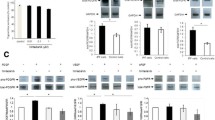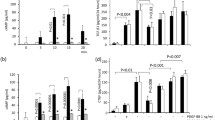Abstract
Fibroblasts are important cells that are involved in modulation of fibrosis after injuries. In some uncontrollable inflammatory processes, excess fibroblasts migrate around the small airway. The pathogenesis of chronic obstructive pulmonary disease is related to fibrosis around the small airways. The aim of the current study was to investigate the effect of procaterol, a second-generation beta (2)-agonist, on migration of human fetal lung fibroblasts (HFL-1) induced by human plasma fibronectin (HFn). Using the blindwell chamber technique, 10−8 M procaterol inhibited migration of HFL-1 (control, 100%; 10−8 M, 73.2 ± 4.9%; n = 6, p < 0.05). The inhibitory effect of procaterol was concentration-dependent. Although a beta 2-receptor inhibitor, ICI 181551, blocked the inhibitory effect of procaterol, a beta 1-receptor inhibitor, atenolol, did not. Because a cyclic AMP-dependent protein kinase (PKA) inhibitor, KT5720, blocked the effect of procaterol, the cyclic AMP–PKA pathway may be involved in the migration inhibitory process. Procaterol, which is prescribed mainly for treatment of bronchial asthma, might be a useful drug for inhibiting lung fibrosis following injuries to the lung.





Similar content being viewed by others
References
Rennard, S. I., M. C. Jaurand, J. Bignon, et al. 1984. Role of pleural mesothelial cells in the production of the submesothelial connective tissue matrix of lung. Am. Rev. Respir. Dis. 130:267–274.
Mirza, Z. N., M. Kato, H. Kimura, et al. 2002. Fenoterol inhibits superoxide anion generation by human polymorphonuclear leukocytes via beta-adrenoceptor-dependent and -independent mechanisms. Ann. Allergy Asthma Immunol. 88:494–500.
Fujisawa, T., Y. Kato, A. Terada, et al. 2002. Synergistic effect of theophylline and procaterol on interleukin-5-induced degranulation from human eosinophils. J. Asthma 39:21–27.
Barnes, P. J. 1999. Effect of beta-agonists on inflammatory cells. J. Allergy Clin. Immunol. 104:S10–S17.
Johnson, M., and S. Rennard. 2001. Alternative mechanisms for long-acting beta(2)-adrenergic agonists in COPD. Chest 120:258–270.
Boyden, S. 1962. The chemotactic effect of mixtures of antibody and antigen on polymorphonuclear leucocytes. J. Exp. Med. 115:453–466.
Kohyama, T., R. F. Ertl, V. Valenti, et al. 2001. Prostaglandin E(2) inhibits fibroblast chemotaxis. Am. J. Physiol. Lung Cell Mol. Physiol. 281:L1257–L1263.
Kohyama, T., X. D. Liu, F. Q. Wen, et al. 2002. Prostaglandin D2 inhibits fibroblast migration. Eur. Respir. J. 19:684–689.
Hunninghake, W. C., K. C. Garret, H. B. Richerson, et al. 1984. Pathogenesis of the granulomatous lung disease (state of art). Am. Rev. Respir. Dis. 130:476–496.
Kohyama, T., X. Liu, F. Q. Wen, et al. 2002. PDE4 inhibitors attenuate fibroblast chemotaxis and contraction of native collagen gels. Am. J. Respir. Cell Mol. Biol. 26:694–701.
Clark, J. G., K. M. Kostal, and B. A. Marino. 1982. Modulation of collagen production following bleomycin-induced pulmonary fibrosis in hamsters. Presence of a factor in lung that increases fibroblast prostaglandin E2 and cAMP and suppresses fibroblast proliferation and collagen production. J.Biol. Chem. 257:8098–8105.
Zhu, Y., C. M. Skold, X. Liu, et al. 2001. Fibroblasts and monocyte macrophages contract and degrade three-dimensional collagen gels in extended co-culture. Respir. Res. 2:295–299.
Mio, T., Y. Adachi, S. Carnevali, et al. 1996. Beta-adrenergic agonists attenuate fibroblast-mediated contraction of released collagen gels. Am. J. Physiol. 270:L829–L835.
Naito, K., T. Nagao, M. Otsuka, et al. 1985. Studies on the affinity and selectivity of denopamine (TA-064), a new cardiotonic agent, for beta-adrenergic receptors. Jpn. J. Pharmacol. 38:235–241.
Acknowledgments
This work was supported in part by grants-in-aid for Scientific Research from the Ministry of Education, Science, Sports, Culture and Technology of Japan, a grant to the Respiratory Failure Research Group from the Ministry of Health, Labour and Welfare, Japan, and grants-in-aid for Comprehensive Research on Aging and Health from the Ministry of Health, Labour and Welfare, Japan. The authors thank Ms. Makiko Kase for her excellent technical assistance.
Author information
Authors and Affiliations
Corresponding author
Rights and permissions
About this article
Cite this article
Kohyama, T., Yamauchi, Y., Takizawa, H. et al. Procaterol Inhibits Lung Fibroblast Migration. Inflammation 32, 387–392 (2009). https://doi.org/10.1007/s10753-009-9147-x
Published:
Issue Date:
DOI: https://doi.org/10.1007/s10753-009-9147-x




